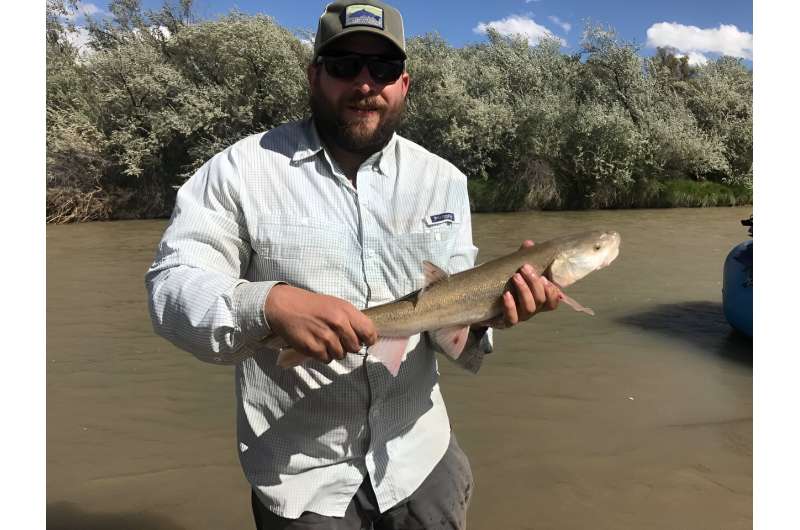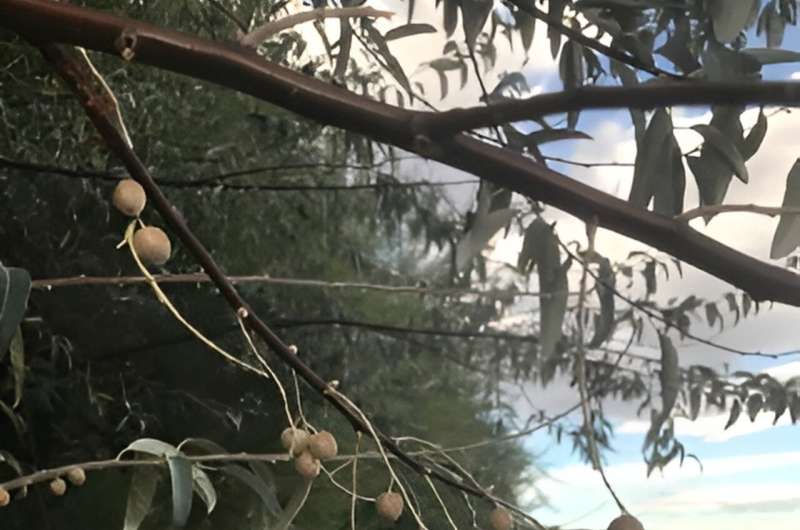This article has been reviewed according to Science X's editorial process and policies. Editors have highlighted the following attributes while ensuring the content's credibility:
fact-checked
trusted source
proofread
Are Russian olive trees fueling an invasive species in the San Juan River?

The San Juan River, a major tributary of the Colorado River located in the "Four Corners" region of the southwestern United States, is home to two native fish species—the Colorado pikeminnow and the Razorback sucker. Both of these species are federally endangered and are being threatened by an invasive species, the channel catfish.
To save the endangered fish, biologists, researchers and wildlife managers have been attempting to better understand how these native and non-native species interact with each other. Christopher Cheek, assistant professor in South Dakota State University's Department of Natural Resource Management, is one of those researchers.
A direct threat
Introduced in the late 1800s, channel catfish are a direct threat to native fish through both predation and competition. While the impacts of non-native fish are difficult to quantify, resource managers have deemed them a direct threat to the native fish population. In fact, the catfish population has grown large enough that in the 1990s, the San Juan River Recovery Implementation Program began efforts to rein back the population size.
For the past 15–20 years, millions of dollars have been spent attempting to control the catfish population through removal efforts. While thousands of catfish have been removed from the river, collapsing the catfish population is nearly impossible, resource managers have stated, and the native fish population has seen little reprieve from the invaders.
While working on a project during his undergraduate studies, Cheek noticed something in the stomachs of channel catfish that few others did: olive fruit from the nearby trees.
"During my undergrad project, the goal was to see if the non-native catfish were eating the endangered fishes," Cheek said. "This is where we first made the observation that catfish were eating the olive fruit."
Fish eating fruit isn't necessarily uncommon—the occurrence is just mainly relegated to fish in the tropics, where fruit is a more abundant resource. In the southwestern U.S., however, catfish eating fruit was not something that had been consistently observed.
"One thing that we do know about catfish is that they will eat mulberry fruits," Cheek said. "Fisherman will target channel catfish under mulberry trees when fruit are dropping in the river so there was some information on fruit/catfish interactions."
While working on his doctorate at Purdue University, Cheek decided to return to the San Juan River and conduct research on interactions between the Russian olive tree—the tree that sprouts olive fruit—and channel catfish, two invasive species that were causing serious ecological impacts to the San Juan River.
Invasive trees and fish
Introduced in the early 1900s to the American West, Russian olive trees were first brought to the U.S. for landscaping and windbreaking purposes. The tree, which can be found on SDSU's main campus, sprouts small cherry-like drupes, which are consumed by birds and other animals that help spread the tree's seed.

This is exactly how Russian olive trees found their way to the banks of many rivers in the southwest, including the San Juan, where it has been the primary cause of increased vegetation cover. According to Cheek, increased vegetation cover along riverbanks contributes to river channel restriction and erosion. Invasive trees, like Russian olives, can also squeeze out native plants.
"In addition to changing channel morphology, olive has the potential to restructure riverine food webs by contributing large seasonal pulses of its fruit and litter," Cheek said. "Understanding the role of invasive riparian trees in aquatic ecosystem function will enhance observation and management of riverine ecosystems."
To begin understanding the interactions, Cheek and the research team first observed channel catfish surfacing on the river to eat the fruit, which could be found floating near shore. They then caught catfish to examine the contents of their stomach.
"What we were surprised by is all the catfish that we were dissecting had olive fruit in their stomachs," Cheek said. "So, it seemed to be more than an opportunistic, occasional thing and we hypothesized that fruit were actually facilitating catfish at the population-level."
After observing a significant amount of olive fruit in the stomachs, the research team had to decipher how much energy the fruit was providing. Was it a primary food source? Did catfish need to eat other things, like native fish, to fuel themselves?
It was estimated that olive fruit comprised 44% of the catfish diet, a significant amount but not enough to entirely fuel them. A variety of other things were also observed in the catfish stomachs.
"Channel catfish are an omnivore so they can take advantage of a wide range of food resources" Cheek said. "They are eating lizards, snakes, birds, algae, aquatic invertebrates, terrestrial vertebrates, crayfish and other fish. Really, they are kind of one of those species that will eat anything available to them. Fish made up less than 5% of their diet, and the larger catfish were doing most of the predation.
"The more data we get on catfish diets in this system, the more we learn the occurrence of predation on these native fish is pretty low," Cheek added. "Catfish are omnivores, so they are eating everything and one of the biggest components was olive fruit, which really surprised us."
As Cheek notes, the size of the catfish is likely the biggest determinant of whether a catfish preyed on the native fish. This logic suggests the removal program is somewhat effective at protecting native fish as it removed mainly larger catfish from the San Juan River.
On the other hand, the research suggests olive fruit may also support higher biomass in the invasive fish, which would increase the catfish population—a net negative for native fish.
While more research needs to be conducted to understand the relationship between native fish, catfish, and Russian olive trees, Cheek is hopeful that these findings will help inform wildlife managers and fish biologists in their future conservation decisions on the San Juan River.
Cheek's research was published in the journal Ecology of Freshwater Fish.
More information: Christopher A. Cheek et al, Diets of invasive channel catfish are subsidized by invasive riparian trees, Ecology of Freshwater Fish (2023). DOI: 10.1111/eff.12753
Provided by South Dakota State University


















